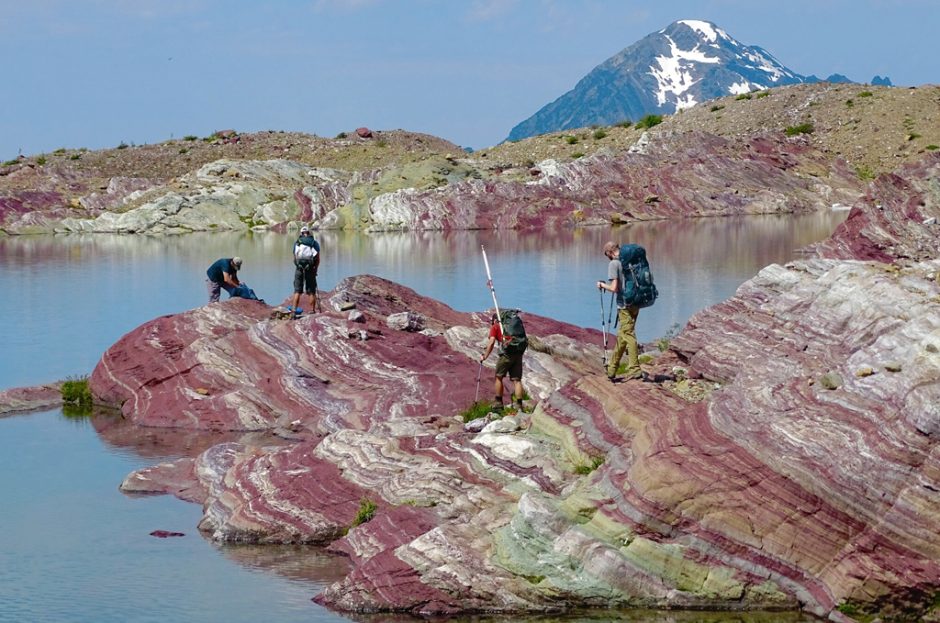Glacier National Park: Sperry Basin Lakes Hold Food Web Mysteries

Researchers prepare to sample a meltwater lake in Glacier National Park. (Credit: Jim Elser / University of Montana)
Most folks don’t question why a lake sits where it is. But at some point in our planet’s history, it’s safe to assume that the water body didn’t exist. Something had to have happened to bring about its creation and stable status as a freshwater ecosystem.
Observing such a transition is incredibly difficult, as we don’t live long enough to view planetary timescales as they shift and mold our world to create new terrains and ecosystems. But things are getting easier nowadays, thanks to new technologies and a globally connected world that allows the scientists of today to access more of the Earth’s wonders.
Clearly one of those is Glacier National Park, a beautiful place to study with lakes that just may hold answers to questions related to the birth of our freshwater treasures. Interestingly, water bodies in the park, many of which are so untouched that they remain unnamed, are in a developmental sweet spot that may offer scientists the chance to see what happens when a lake begins to shift from giant puddle to bustling ecosystem.
In a work that is just beginning, investigators with the University of Montana and U.S. Geological Survey have recently sampled lakes in the Sperry Basin of the national park. Their efforts rely on simple techniques and gear at this point, but with a little luck and funding, they hope to ramp up study of the lakes to learn more about the critical point their food chains begin to develop.
“We’re most interested in the colonization of different parts of the food web. When we were there, we couldn’t hardly see any (plankton) at all. There’s not a lot of zooplankton yet, and some of these lakes are 40 or 50 years old,” said Jim Elser, director of U. of Montana’s Flathead Lake Biological Station. “The question is how long does it take to amass a pelagic food web.”

Meltwater lake in Glacier National Park. (Credit: Jim Elser / University of Montana)
Elser likes to say that his recent trip to Glacier National Park was like a trip back in time to the Pleistocene when there was no one around to sample lakes. The expedition this past summer was the first to the study site, which holds six shallow water bodies of interest to the crew that includes the U.S. Geological Survey’s Joe Giersch and Clint Muhlfeld.
Muhlfeld is a research ecologist with the agency while Giersch is an aquatic entomologist. Both have done extensive studies in the park before. For Giersch, the Sperry Basin lakes are just a stone’s throw from other water bodies he’s researched to help protect the western glacier stonefly, a rare, endemic insect threatened by glacier loss.
Both were useful guides for Elser’s trip — Giersch has some excellent maps showing the lakes going back to 2000 — and each also helped with sampling the lakes. Those efforts involved gathering discrete water samples for chemical analysis back in the lab. Plankton nets were also used, as well as handheld water quality meters that tracked parameters including temperature, pH, dissolved oxygen and conductivity.
“They’re pretty dynamic water bodies and there are lots of things to be done here to understand how lakes were like when they first formed,” said Elser, noting that some of the glacial flour-filled lakes have shifted color since Giersch’s maps captured them. They were once a bright turquoise but are now a clear blue. “…The only data I’ve looked at so far is from the meters, and the conductivity is extremely low. That’s not surprising because there’s nothing in the water. Conductivity is a reflection of all the things dissolved in the water, from rocks, soil substrate, atmospheric deposition, and these waters are extremely fresh.”

Lakes in Glacier National Park, partially colored by glacial flour. (Credit: Jim Elser / University of Montana)
The levels were about 10 times lower than what he’s used to seeing, Elser says, and he is eager to make more discoveries into the lakes’ processes. In the future, he’d like to instrument the water bodies with in-situ sensors that can gather data over the long term.
But since the lakes are located in a national park, there are likely restrictions on the gear that researchers can deploy. And tackling the water bodies’ food webs is tough because each of the lakes are only about 3 to 5 meters deep. A profiler is pretty much out of the question.
“I wonder if they even stratify. I don’t know,” said Elser, adding that the crew didn’t take a boat along for that first trip.
To answer that and many other questions, he is going to need some help from researchers who are doing similar work. So far those folks have proven hard to find, but Elser has a few lines out with researchers in China and Tibet. There are also some scientists at the University of Maine who have useful expertise.
“Researching these water bodies will advance our understanding of how the history of lakes comes about,” said Elser. That will aid understanding of the Sperry Basin lakes and other freshwater bodies in a future of predicted climate changes. “This is the water capital of the western U.S. and the functions of lakes and streams are going to change. What roles do these lakes play in contributing to downstream water quality?”
Elser is also interested in learning more about the lakes’ relationships with nutrients like nitrogen and phosphorus, as well as their contributions to carbon dioxide in the atmosphere as the glaciers around them melt.
Top image: Researchers prepare to sample a meltwater lake in Glacier National Park. (Credit: Jim Elser / University of Montana)





0 comments